SpaceX’s Dragon spacecraft may be appearing in a backyard sky near you this weekend. Scheduled to launch this Friday on March 1st at 10:10 AM Eastern Standard Time (EST)/15:10 Universal Time (UT), this will be the 3rd resupply flight for the Dragon spacecraft to the International Space Station (ISS). And the great news is, you may just be able to catch the spacecraft as it chases down the ISS worldwide.
The Space Shuttle and the ISS captured by the author as seen from Northern Maine shortly after undocking in June, 2007.
Catching a satellite in low Earth orbit is an unforgettable sight. Satellites appear as moving “stars” against the background sky, shining steadily (unless they’re tumbling!) in the sunlight overhead in the dawn or dusk sky. Occasionally, you may catch a flare in brightness as a reflective panel catches the sunlight just right. The Hubble Space Telescope and the Iridium constellation of satellites can flare in this fashion.
At 109 metres in size, the ISS is the largest object ever constructed in orbit and is easily visible to the naked eye. It has an angular diameter of about 50” when directly overhead (about the visual size of Saturn plus rings near opposition). I can just make out a tiny box-like structure with binoculars when it passes overhead. If the orientation of the station and its solar panels is just right, it looks like a tiny luminous Star Wars TIE fighter as viewed through binoculars!
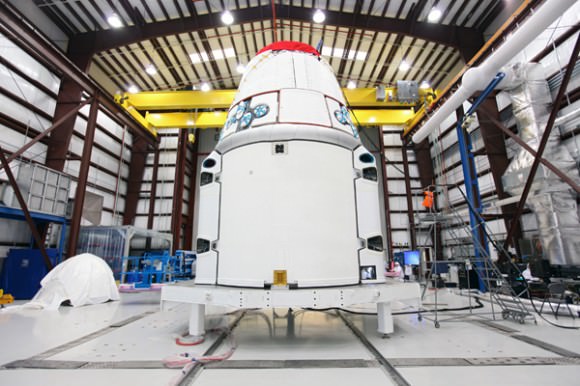
But what’s even more amazing is to watch a spacecraft rendezvous with the ISS, as diligent observers may witness this weekend. Your best bet will be to use predictions for ISS passes from your location. Heavens-Above, CALSky and Space Weather all have simple trackers for sky watchers. More advanced observers may want to use an application known as Orbitron which allows you to manually load updated Two-Line Element sets (TLEs) from Celestrak or NORAD’s Space-Track website for use in the field sans Internet connection. Note that Space-Track requires permission to access; they welcome amateur sat-spotters and educators, but they also want to assure that no “rogue entities” are accessing the site!
The Falcon-9 rocket with the Dragon capsule launches just five minutes behind the ISS in its orbit Friday. It’s worth noting that the Middle East has a chance at seeing the Falcon 9 and Dragon on first orbit shortly after launch in the dusk sky. A Falcon launch produces a fair amount of extra hardware to track as well. During last year’s pre-dawn COTS-2 launch in May, observers in the northern United States caught sight of four pieces of hardware in close formation after the first orbit. These were also tracked and cataloged by NORAD, and are thought to have been the Dragon capsule, the Falcon 9 rocket second stage, and either the payload clam-shells or solar panel fairings.
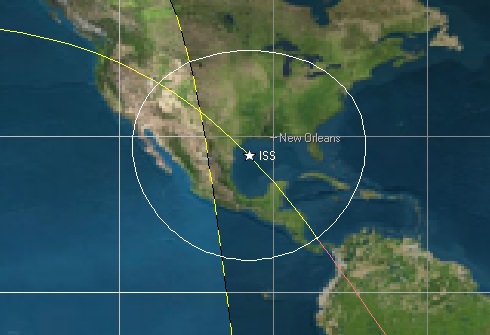
Orbital geometry for ISS sightings this weekend will favor latitudes from +10° through +45° degrees north for evening passes to -20° to -50° degrees south for dawn passes. Capture and berthing of the Dragon will occur only 20 hours after launch on March 2nd at 6:30 AM EST/ 11:30 UT, so Friday night at dusk will be the ideal time to catch Dragon chasing down the ISS. The ISS is unmistakable, shining a magnitude -1 to -2. Start watching for the Dragon capsule a few minutes prior to the scheduled pass as a +1 to +2 “star” either in front of or behind the ISS. The difference may be up to several minutes, so keep watching! The Dragon capsule and associated SpaceX hardware will follow the same 52.6° inclination orbit as the ISS. The sight of the Dragon chasing the ISS was caught by observers across the southern U.S. on three successive dusk passes last year in October during the CRS-1 mission.
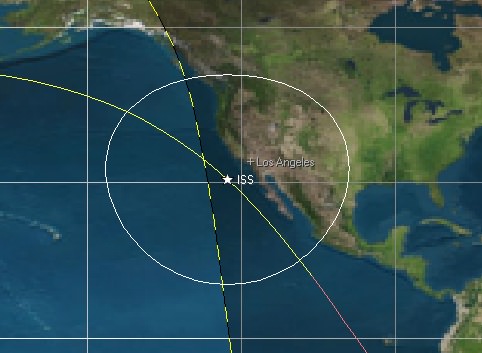
The best passes Friday night (March 1st) will be around 6:45 CST/00:45 UT (March 2nd) for the south-central U.S. and 6:20 PST/02:20 UT (March 2nd) for the southwestern U.S. Note that if the launch scrubs, these predictions will change accordingly. NORAD tracking TLEs generally go up a few hours after launch, and of course, we’ll be reporting all of the orbital action via Twitter!
Although fainter than the Space Shuttle, the Dragon is easily a naked eye object under clear dusk skies. With the completion of the Space Shuttle program in 2011, Dragon gives the U.S. cargo accessibility to the ISS once again. It thus joins JAXA’s HTV, ESA’s ATV, and the Russian Soyuz/Progress vehicles as frequent flyers to the ISS. And although Soyuz currently provides the only crewed access to low-Earth orbit, SpaceX plans to start using the Dragon for the same as early as 2015.
For skilled observers, it’s even possible to image and track satellites in low Earth orbit. We use a very low tech method to accomplish this. Seasoned satellite tracker Ralf Vandebergh has been able to nab the Falcon 2nd stage in orbit from the ground;
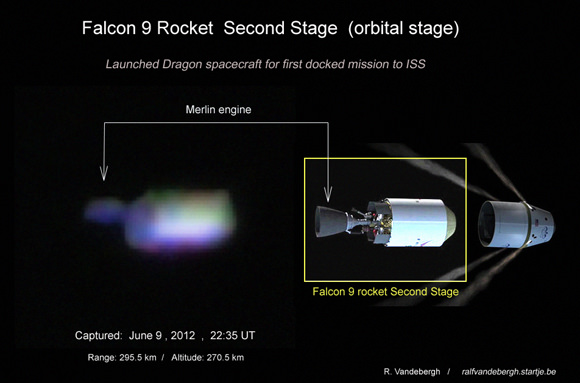
Also, we just learned recently that the Falcon rocket booster from the original SpaceX COTS 1 launch is still in a 300 by 10,772 kilometre elliptical orbit! Listed as NORAD ID 37253/2010-066K, it reaches as bright as -1 magnitude on a perigee pass… a fine catch!
If you’ve got an ISS pass overhead on Friday or Saturday, be sure to watch for the Dragon capsule on approach to berthing. We’ll be attending the launch and will be looking skyward as the Falcon 9 rocket arcs off on its race to catch the ISS headed to the northeast. It’s great to see payloads chasing after the ISS leaving the U.S. Florida Space Coast once again!
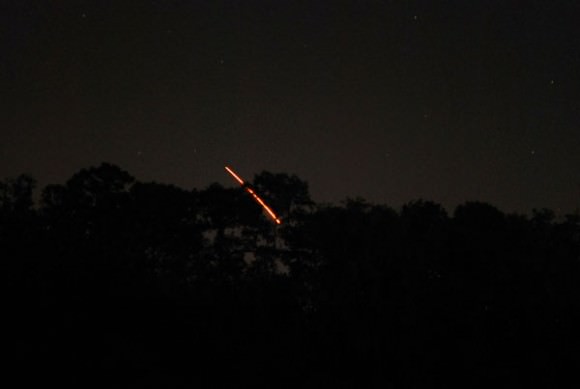
See more of Ralf Vandebergh’s outstanding work at Telescopic Spaceflight Images.

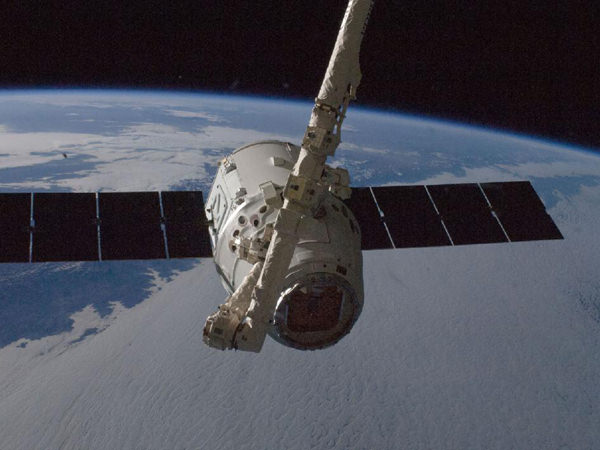
I’m a little confused, this mentions Friday the 2nd.
Why are there still Falcon parts in orbit? Should they be adding to space junk like that?
They didn’t say the parts from the May launch were still in orbit. They quite probably are not.
For those with real satellite tracking programs, here are the two-line elements for ISS as of February 26:
ISS (ZARYA)
1 25544U 98067A 13056.02131944 .00008856 00000-0 14952-3 0 2892
2 25544 51.6489 305.4203 0011052 308.7565 242.9655 15.52411420817289
The key US passes occur locally Friday night on the 1st; they happen on the 2nd as reckoned in Universal Time.